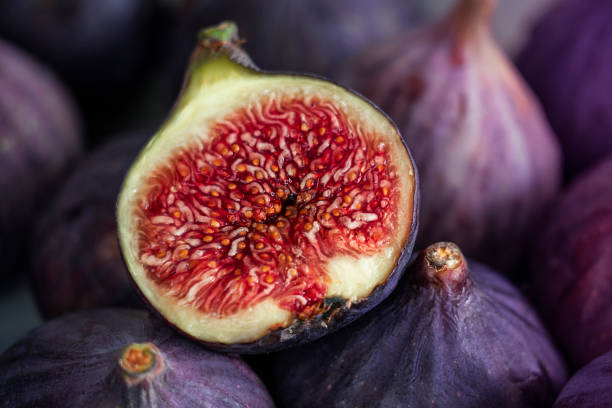What to Eat and Drink
Eat Figs To Get Its Maximum Benefits
Discover how to appreciate the myriad health benefits of figs with our complete guide to eating this wonderful fruit. Figs are high in fiber, vitamins, and minerals, making them a nutritional powerhouse that can help with digestive health, immunological function, and even weight loss. But, are you making the most of your fig-eating experience?
In this article, we’ll reveal the secrets of optimizing the nutritious value of figs. We’ll give you professional advice on everything from choosing the ripest ones to finding new ways to incorporate them into your diet. Discover how to relish the sweet and succulent flavor of this ancient fruit and include it into your healthy lifestyle.
This guide is for you, whether you’re a fig fan seeking for new ideas or someone who’s never tried figs before. So take a handful of these nature’s treats and prepare to experience the rich flavor and health benefits of figs like never before. Let’s delve into the amazing world of figs and discover their full potential.

Understanding the Nutritional Value of Figs
Figs are not only delicious, but they also contain critical elements that can provide benefits and improve your overall health. These little fruits include a high concentration of dietary fiber, which improves digestion and promotes gut health. Figs also include a range of vitamins and minerals, such as vitamin C, potassium, magnesium, and calcium, all of which are necessary for proper bodily function.
One of the most notable nutritional aspects of figs is their high fiber content. Fiber not only helps regulate bowel motions, but it also aids in weight management by producing a sense of fullness and decreasing overeating. Furthermore, figs are low in calories and fat, making them a perfect snack for weight watchers.
Figs are high in fiber and antioxidants, which can help protect your body from damaging free radicals. Antioxidants have an important role in decreasing inflammation and preventing chronic diseases including heart disease and cancer.
So, the next time you grab for a fig, remember that you’re not only satisfying your taste buds but also providing your body with a variety of critical nutrients.

How to Choose and Store Fresh Figs
When it comes to choosing fresh figs, there are a few important aspects to consider to ensure the finest quality and flavor. Look for plump, supple figs that yield slightly when gently squeezed. Avoid figs that are too mushy or have bruised or broken skin, as these could suggest deterioration.
Color is also a good sign of maturity. Ripe figs can be deep purple or greenish-yellow, depending on the type. A darker color denotes ripeness in most fig kinds, but a lighter shade suggests that the fig has not yet fully ripened.
If you have the option, choose ripe, ready-to-eat figs. However, if you can only get slightly underripe figs, leave them to ripen at room temperature for a few days. Place them in a single layer on a plate or shallow bowl, away from direct sunlight.
Once your figs have ripened, store them in the refrigerator to increase their shelf life. To avoid moisture buildup, store them in a ventilated container, such as a perforated bag or a loosely covered container. Fresh figs that are properly preserved can last up to a week in the refrigerator.
Remember that figs are delicate fruits, so treat them with caution to avoid bruising or injuring the tender flesh.
The Best Ways to Eat Figs for Maximum Health Benefits
Now that you’ve chosen the ideal figs, it’s time to discover the finest ways to consume them in order to maximize their health benefits. While eating fresh figs off the tree is unquestionably enjoyable, there are plenty other delectable options to consider.
One simple way to enjoy figs is to eat them on their own or with other fruits, cheeses, or nuts. Figs, with their natural sweetness and smooth texture, form a delicious and healthful snack.
Another common method to eat figs is to add them to salads. Simply slice fresh figs and combine with mixed greens, goat cheese, walnuts, and a light vinaigrette. The combination of flavors and textures results in a refreshing and healthful salad.
If you’re feeling daring, consider grilling or roasting figs for a caramelized and enhanced flavor. Drizzle them with honey and balsamic sauce and serve as a side dish or dessert. Grilled or roasted figs work well with a range of cheeses, including blue cheese and ricotta.
For a quick breakfast or snack, spread almond butter or cream cheese on a slice of whole grain bread and top with sliced figs. Add a pinch of cinnamon or drizzle with honey for an added boost of flavor.
If you enjoy baking, figs make a great addition to cakes, muffins, bread, and tarts. To plump dried figs, soak them in warm water or juice before using them in your favorite baked products.
Remember, there are limitless ways to incorporate figs into your diet to get its benefits. Get creative and try out different combinations to uncover your favorite fig-inspired recipes.

Recipes and Ideas for Incorporating Figs into Your Diet
Looking for particular recipes and ideas for incorporating figs into your diet? Here are some tasty and nutritious options to get you started:
- Fig and Goat Cheese Stuffed Chicken Breast: Cut a pocket into a boneless, skinless chicken breast and stuff it with a mixture of chopped figs, goat cheese, and fresh herbs. Bake until the chicken is cooked through and the filling is oozy and delicious.
- Fig and Arugula Pizza: Spread a thin layer of fig jam or sliced fresh figs onto a pre-baked pizza crust. Top with arugula, prosciutto, and crumbled goat cheese. Bake until the cheese melts and the crust is golden brown.
- Fig and Walnut Granola Bars: Combine oats, crushed walnuts, dried figs, honey, and a pinch of salt to create a sticky mixture. Press the mixture into a baking dish and bake until golden and firm. Cut into bars and enjoy as a healthy on-the-go snack.
- Fig and Coconut Chia Pudding: Mix chia seeds, coconut milk, and a touch of honey in a jar or bowl. Let the mixture sit in the refrigerator overnight to thicken. Top with sliced figs and shredded coconut before serving.
These are just a few examples to spark your culinary creativity. Feel free to adapt and modify these recipes to suit your taste preferences and dietary needs.

Potential Side Effects and Precautions When Consuming Figs
While figs are typically safe to consume, some people may experience negative effects or need to take additional measures.
Side Effect 1: Allergic Reactions
Figs are in the mulberry family and can trigger allergy reactions in people who are allergic to other fruits in the same family. If you have a known allergy, it is important to check your doctor before eating figs.
Side Effect 2: Diarrhea or Upset Stomach
Because of their high fiber content, eating a lot of figs in a short period of time may induce digestive issues like diarrhea or an upset stomach. To avoid these negative effects, you should listen to your body and take figs in moderation.
Precaution 1: Interactions with Medications
Figs contain a chemical called psoralen, which can interfere with some drugs, particularly blood thinners. If you are on any drugs, particularly blood thinners or anticoagulants, you should consult with your doctor before eating significant amounts of figs.
Precaution 2: Oxalate Content
Figs contain oxalates, which can cause kidney stones in sensitive people. If you have a history of kidney stones or are at risk, limit your fig consumption and speak with your doctor for personalized guidance.
Trusted Health, Wellness, and Medical advice for your well-being


